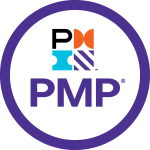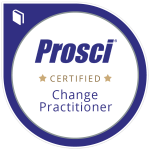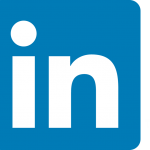 “Plans are worthless, but planning is everything” Dwight D. Eisenhower1
“Plans are worthless, but planning is everything” Dwight D. Eisenhower1
As we work through strategy, there is a natural cascade, or progression, from “why” to “what” to “how”. We need to drive the directional thinking (“why” and “what”) down into execution (“how”) because, and we should keep reminding ourselves of this, at the end of the day we need to deliver business results.
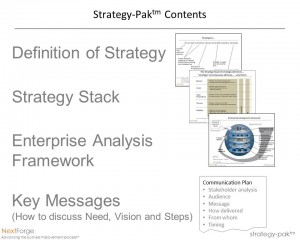 Recall our point of view- the “why” to “what” of strategy is addressed at the top of what we call the strategy stack. To ensure alignment between all the bits and parts, we embark upon an analysis effort, the planning, to check for congruence among all of the moving parts.
Recall our point of view- the “why” to “what” of strategy is addressed at the top of what we call the strategy stack. To ensure alignment between all the bits and parts, we embark upon an analysis effort, the planning, to check for congruence among all of the moving parts.
As we begin to think about how we go to market holistically, we can revisit our General Management Framework mental model, including an understanding of our environment.
 The environmental assessment framework establishes the context for decisions we make. It helps us understand pressures on our customers and on our competitors. All of these environmental factors are then considered when defining potential scenarios for planning.
The environmental assessment framework establishes the context for decisions we make. It helps us understand pressures on our customers and on our competitors. All of these environmental factors are then considered when defining potential scenarios for planning.
A side-bar on scenarios: We tend to use a scenario development methodology which pits highly impactful and highly uncertain dimensions against each other in pairs. For each pair of dimensions in a 2×2 matrix creates four potential scenarios. The art is in choosing the right dimensions and the right pairs.
What’s missing? Sales!
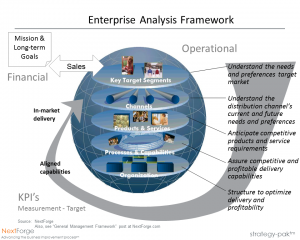 Sales is the linchpin locking the operations drive-shaft (what we know and do) to the power-wheel of execution toward our long-term goals and mission (what we aspire to be, what we plan to achieve). Without profitable sales, all of the leadership, management, analysis, planning and exceptional execution in the world is nothing more than an interesting supply-chain exercise.
Sales is the linchpin locking the operations drive-shaft (what we know and do) to the power-wheel of execution toward our long-term goals and mission (what we aspire to be, what we plan to achieve). Without profitable sales, all of the leadership, management, analysis, planning and exceptional execution in the world is nothing more than an interesting supply-chain exercise.
A quick walk through the framework
Consider this conceptual example using the “Enterprise Analysis Framework” for positioning and alignment. Start with our target customers- What are their needs and preferences? What is going to drive their behavior to purchase and consume our product?
Next up- Think through our distribution channels along two dimensions 1) customer penetration and 2) how we deliver value for each channel- What are our channel specific value propositions?
Now that we understand the bundle(s) of goods and services, what is required to win with our customers and win with our channel partners? Also, don’t forget to consider competitive pressures and trends (products, environment, competition, etc.)- What processes and capabilities are required to profitably deliver the bundles? What are our priorities for these requirements?
Finally, which almost always causes some friction with our clients (because of their managerial bias to re-organize), once we figure out what needs to be accomplished – we test for the best organizational structure. This usually leads us to the structure with the least downside, as no organization structure is perfect (See our coverage of one approach the Network Organization overlay in Change Leadership II- Understanding Kotter).
How do we use this?
We believe it takes a couple of cycles through this analysis – top to bottom and back up again- including getting stakeholder feedback, before strategy is aligned and ready for execution. During each turn of the crank, we need to include risk assessment and contingency planning to help harden our working draft plans. As President Eisenhower reminds us- it is the act of planning which prepares us, as we most often do not execute exactly to plan. Taken in the modern, social context, it is becoming easier every day to involve and engage more people for more robust planning and a more robust plan.
A mini-case example
Not too many projects ago, we created a vetting process for functional transformation of a large financial services company. The transformation “strategy”, developed quickly by a few, included executional plans. Our organizing concept for vetting brought together stakeholders and experts for each of the four primary themes. With a common vetting deliverable format, each theme-team worked in a unique SharePoint website and reviewed the work-product of the other theme-teams. The level of engagement and transparency boosted the morale of the function, increased their understanding of the overall business strategy, and seeded commitment to the overall transformation as well as to the sponsoring executive.
This is the fourth post in a definitional series on the key elements of strategy. We will continue to include a few observations along the way on how we have, or might, advance the more traditional concepts. Collectively, we refer to the grouping of strategic concepts as the strategy-paksm.
1There are a number of variations around the exact wording of Eisenhower’s quote, we have chosen a passage from WikiQuote.org as it seemed to be pulled directly from a speech to the National Defense Executive Reserve Conference in Washington, D.C. (November 14, 1957). [Internet] [Cited November 9, 2012] Available from http://en.wikiquote.org/wiki/Dwight_D._Eisenhower


